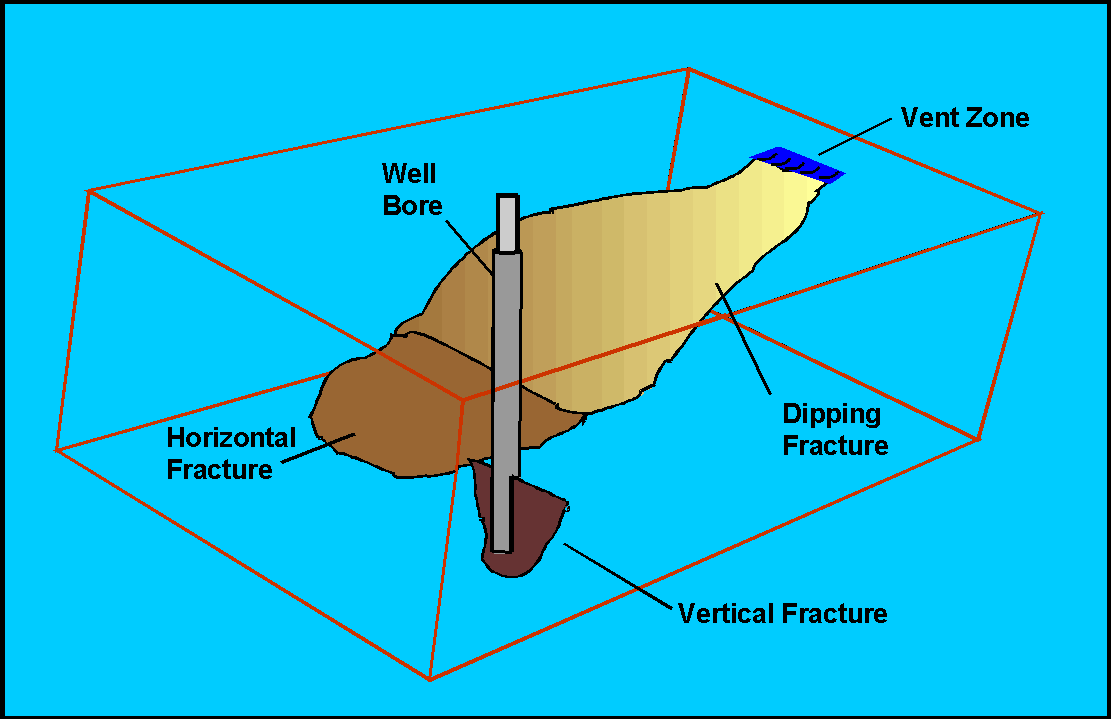|
2 The 4 Technology Solutions

ENHANCED GROUNDWATER REMEDIATION,
PART II: PHYSICAL PROCESSES
An On-Line Version of a Column First Published in:
Environmental Technology July./Aug. 1998 Vol. 8 No. 4 Page 44
By: David B. Vance dbv7@mindspring.com
Available reaction processes for Enhanced Groundwater Remediation were covered in the previous groundwater column. This column will begin a discussion on the application of physical processes. Pump and Treat can be considered such a process, but our focus is on processes that will improve saturated zone mass transport rates beyond that achievable with Pump and Treat alone. The dominant enhancement technology available for application under saturated groundwater conditions is Hydraulic Fracturing. The rational for Hydraulic Fracturing is simple, the rate of groundwater flow in a fracture is proportional to the cube of the fracture aperture. In fine grained low permeability silts and clays a fracture can increase flow rates by an order of magnitude or more. Even then the rate limiting step for advective groundwater flow will not be the carrying capacity of the fracture itself, but the capacity of the fine grained aquifer matrix to yield water into the fracture.
Equipment required includes above ground tanks and pumps; and in the subsurface a packer to isolate discrete intervals within the well bore, and a method of cutting a notch into the formation sediments adjacent to the well bore to serve as a nucleation point from which the fracture will originate. Once created, fractures are kept open by the injection of a proppant. This is an aqueous suspension of coarse sand, a viscosity agent such as guar gum gel, and an enzyme to break down the gel after the fracturing/proppant injection process is complete. Four to six fractures can be completed per day at a cost of $1,000 to $1,500 each.
Pumps must be capable of generating injection pressures that will exceed the overburden pressure as well as an additional 15 to 30 PSI to overcome other forces such as soil cohesion. A rough "rule of thumb" for the overburden pressure of soils is a gradient of 1 PSI for each foot of depth.
A key consideration for the application of hydraulic fracturing to a site is the spatial orientation of the fractures generated by the process. The creation of vertical, dipping or horizontal fractures is possible, with horizontal fractures usually the most desirable (see the Figure). In overconsolidated formations the predominant fracture direction should be horizontal. Relevant examples of soils that can be in an overconsolidated condition include glacial drift in the Midwest and Northeast and swelling clays along the Gulf Coast. Many alluvial surface deposits are not overconsolidated, in these normally consolidated sediments where horizontal stress is less than the vertical stress, fractures tend to propagate vertically or steeply dipping. Either of which can vent to the surface. The degree of consolidation (and resulting state of stress) is dependent upon the geologic history of the site, although it is difficult to predict results without in-situ testing.

Fractures can typically be propagated to radial distances from the injection well of 20 to 25 feet. The process causes an inch or so of uplift on the surface above the injection zone, which can serve as a monitoring tool for the extent of the fracture propagation. This is not sufficient to overly disturb roadways or most buildings, although it may be prohibitive for application beneath fixed structures containing dynamically sensitive operations (such as semiconductor manufacturers).
Lastly, it is also important to consider the physical transport dynamics of an aquifer that has been conditioned by hydraulic fracturing. The increased groundwater flow rate may not result in a directly proportionally greater recovery rate of contaminants. The fractures will occupy discrete zones within a low permeability matrix, zones directly adjacent to the walls of fractures will yield their contaminant load rapidly. However, the remainder must still rely on diffusional transport through the low permeability matrix to the fracture. A considerably slower process than the advective flow through the fracture. Hydraulic fracturing will make enhanced remediation possible in such soils, but it will still not make it an instantaneous process. Increasing fracture density will further decrease remediation times with a concurrent increase in installation costs.
Return to the Environmental Technology Index Page
Copyright 2008 David B. Vance
All Rights Reserved

If you have comments or suggestions, email me at dbv7@mindspring.com
|